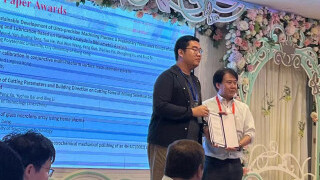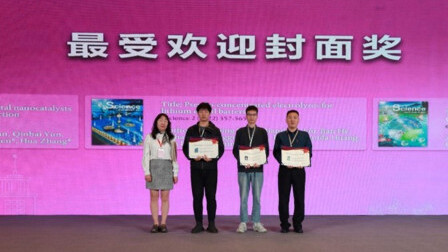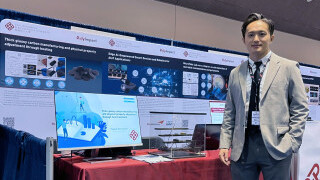Innovative Air Electrode Material Boosting Efficiency and Durability of Reversible Protonic Ceramic Electrochemical Cells for Green Energy Application
Other Articles

Developing a novel bifunctional air electrode material which improves the efficiency and durability of reversible protonic ceramic electrochemical cells.
Study conducted by Prof. Meng NIand his team
In light of fossil fuel shortage and the harmful effects of greenhouse gas emissions, there is growing interest in efficient, sustainable, and eco-friendly energy solutions. Reversible protonic ceramic electrochemical cells (R-PCECs) enable high-efficiency power generation and green hydrogen production at intermediate temperatures (500 – 700 oC). Unlike conventional oxygen ion-conducting reversible solid oxide cells (R-SOCs) working at 800 oC or above, R-PCECs operate at lower temperatures due to fast proton transport and lower activation energy, improving lifespan while reducing production and operating costs. Thus, R-PCECs are very promising for efficient and durable clean power generation. Compared with room temperature electrolysers such as alkaline electrolysers and proton exchange membrane electrolysers, R-PCECs show much lower power consumption, higher efficiency, and lower hydrogen production cost (potentially 30% lower).
However, achieving adequate electrochemical performance of air electrodes poses a significant challenge for R-PCECs. The challenge lies in the sluggish kinetics of the oxygen reduction reaction (ORR) and oxygen evolution reaction (OER), and low durability. It is vital to develop effective strategies to boost the ORR/OER electrode kinetics and durability to expedite the development of R-PCECs.
A research team led by Prof. Meng NI, Chair Professor of Energy Science and Technology of the Department of Building and Real Estate and Associate Dean (Research) of the Faculty of Construction and Environment at The Hong Kong Polytechnic University, has discovered how to synthesise a novel bifunctional air electrode material (N-BCFZYNF) by concurrently modifying bulk-phase metal-oxygen bonds and in-situ surface formation of metal oxide nano-catalysts [1]. The team presents a rational design strategy to produce high-performance R-PCEC air electrodes with superior operational activity and stability for efficient and sustainable energy conversion and storage. The research study, “Synergistic Bulk and Surface Engineering for Expeditious and Durable Reversible Protonic Ceramic Electrochemical Cells Air Electrode,” has been published in the journal Advanced Materials.
As the OER/ORR processes involved both processes occurring on the surface and bulk of the catalyst, it is thus reasonable to improve both surface and bulk properties of the air electrodes. Synergistic optimisation effects at both bulk and surface modifications considerably strengthen the electrochemical environment for interactions involving oxygen and protons, which have been evidenced in substantially improved oxygen adsorption/desorption and hydration rates, as well as in enhanced capabilities for oxygen ion and proton transport in both surface and bulk. These improvements are considered favorable for optimising electrode kinetics. The sluggish ORR/OER kinetics of the parent BaCo0.4Fe0.4Zr0.1-Y0.1O3–𝛿Note1 air electrode are greatly accelerated, ensuring the outstanding electrochemical performance of the N-BCFZYNF catalyst in fuel cell (FC) and electrolysis cell (EC) modes.
This use of N-BCFZYNF aims to improve the ORR/OER electrocatalytic performance of air electrodes with triple conductivity (O2−, H+, e−). The specifically engineered air electrode nanocomposite-Ba(Co0.4Fe0.4Zr0.1Y0.1)0.95Ni0.05F0.1O2.9-𝜹 exhibits exceptional ORR/OER catalytic activity and durability in R-PCECs. This is evidenced by a significant rise in peak power density from 626 to 996 mW cm−2 and excellent stability over a 100-hour cycling period (Figure 1).

Figure 1. The electrochemical performance of R-PCEC with BCFZY and N-BCFZYNF air electrodes: the comparison i–V–p curves of the Ni-BZCYYb supported PCFCs with a) the pristine BCFZY electrode and b) N-BCFZYNF electrode at 500-650 °C
In conclusion, the physicochemical properties of this novel bifunctional air electrode are systematically analysed, revealing that synergistic bulk and surface optimisations enhance the electrochemical environment for oxygen and proton interactions. This leads to improved oxygen adsorption/desorption, hydration rates, and ion/proton transport. As a result, the sluggish ORR/OER kinetics of the parent BCFZY air electrode are significantly accelerated, ensuring excellent performance of the N-BCFZYNF catalyst in FC and EC modes. Looking ahead, this approach also holds promise for the exploration of catalysts in other electrochemical systems.
The research is supported by grants from the Research Grants Council, University Grants Committee, Hong Kong SAR (Project Numbers: 15306723 and SRFS2324-5S02) and the National Nature Science Foundation of China (Grant number: 22209138), Guangdong Basic and Applied Basic Research Foundation (Grant number: 2021A1515110464). The authors gratefully acknowledges the Research Grants Council of Hong Kong for support through project grants 16201820 and 16201622. This research was also partly supported by the Hetao Shenzhen-Hong Kong Science and Technology Innovation Cooperation Zone (Project number: HZQB-KCZYB-2020083). The authors additionally extend their gratitude to Shiyanjia Lab (www.shiyanjia.com) for providing assistance with the XPS test.
Supporting information for this study is available from the Wiley Online Library or from the corresponding author. The data that support the findings of this study are available from the corresponding author upon reasonable request.
Prof. Ni’s research focuses on clean energy conversion and storage, especially high temperature electrolysers and fuel cells for hydrogen production and utilisation. He was ranked among the top 2% most-cited scientists worldwide (career-long) by Stanford University for six consecutive years from 2019 to 2024. Prof. Ni is currently the Associate Dean (Research) of the Faculty of Construction and Environment at The Hong Kong Polytechnic University.
| Note |
|---|
This is a prototypic perovskite triple-conducting oxide (TCO).
| Reference |
|---|
[1] Chen, X., Yu, N., Song, Y., Liu, T., Xu, H., Guan, D., Li, Z., Huang, W., Shao, Z., Ciucci, F., & Ni, M. (2024). Synergistic bulk and surface engineering for expeditious and durable reversible protonic ceramic electrochemical cells air electrode. Advanced Materials, Volume 36, Issue 32, August 2024, 2403998. Wiley-VCH Verlag GmbH & Co. KGaA. https://doi.org/10.1002/adma.202403998
 | Prof. Meng NI Associate Dean (Research) |




